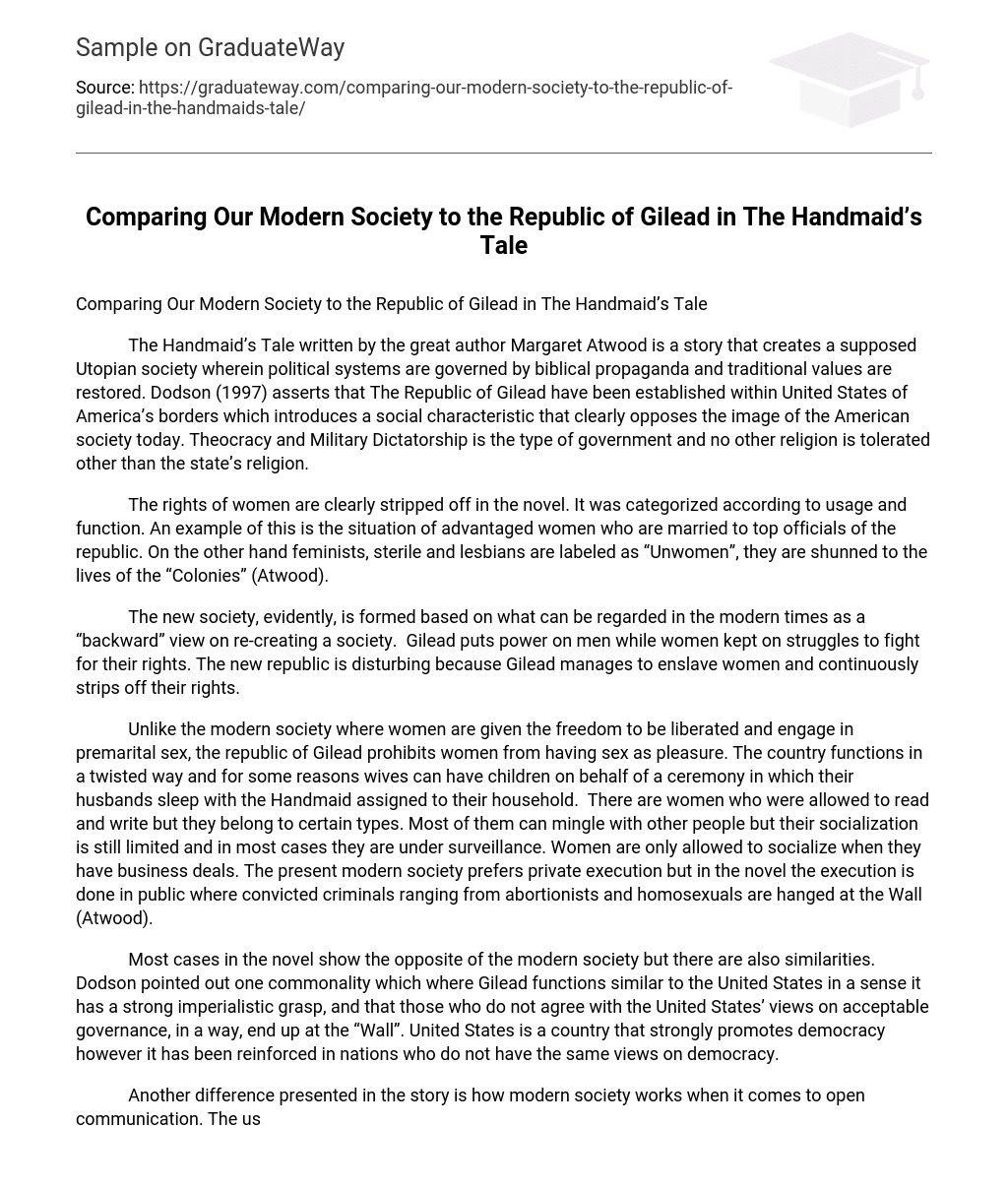The Handmaid’s Tale, written by the great author Margaret Atwood, tells the story of a supposed Utopian society where political systems are governed by biblical propaganda and traditional values are restored. According to Dodson (1997), The Republic of Gilead has been established within the borders of the United States of America, introducing a social characteristic that clearly opposes today’s American society. The government is a combination of Theocracy and Military Dictatorship, with no other religion tolerated besides the state’s religion.
The novel clearly strips women of their rights. Women are categorized based on their usage and function. For instance, women who are married to top officials of the republic are considered advantaged. However, feminists, sterile women, and lesbians are labeled as “Unwomen” and they are shunned to live in the “Colonies” (Atwood).
The new society is evidently formed based on what can be regarded in modern times as a backward” view of re-creating a society. In Gilead, power is placed on men while women continue to struggle to fight for their rights. The new republic is disturbing because Gilead manages to enslave women and continuously strip away their rights.
Unlike modern society, where women are given the freedom to engage in premarital sex and be liberated, the Republic of Gilead prohibits women from having sex for pleasure. The country operates in a twisted way, and for some reason, wives can have children on behalf of a ceremony in which their husbands sleep with the Handmaid assigned to their household. Certain types of women are allowed to read and write, but most of them still have limited socialization and are under surveillance. Women are only allowed to socialize when they have business deals. In the novel, executions are done publicly where convicted criminals ranging from abortionists to homosexuals are hanged at the Wall (Atwood).
Most cases in the novel show the opposite of modern society, but there are also similarities. Dodson pointed out one commonality: Gilead functions similarly to the United States in a sense that it has a strong imperialistic grasp. Those who do not agree with the United States’ views on acceptable governance, in a way, end up at the “Wall”. The United States is a country that strongly promotes democracy; however, it has been reinforced in nations that do not share its views on democracy.
Another difference presented in the story is how modern society works when it comes to open communication. The use of language in the novel is guided by verbal hygiene, which is implemented through formal communication (Cavalcanti). The Republic of Gilead is truly the opposite of what modern society represents. However, there are themes presented in the novel that show a context of dystopia that can also exist today. A nightmare is presented in Gilead due to power and control by people in authority. Suppression and execution are also viewed as the only solutions to end problems faced by society. It is an evident factor that modern society can exhibit at present times.
The concept of Utilitarianism is prevalent in the novel and applicable at present. The benefit of the majority’s happiness and pleasure is always considered, even if it means degrading women and treating them as sexual symbols to prioritize the survival of the Gilead population. This is a clear opposite of modern society, where women are well-respected and given opportunities to lead.
Works Cited:
Book Review: The Handmaid’s Tale by Margaret Atwood
http://www.allreaders.com/Topics/Info_5083.asp
Atwood, Margaret. The Handmaid’s Tale. Toronto: Seal, 1985.
Cavalcanti, I. Utopias of Language in Contemporary Feminist Literary
Dystopias. Utopian Studies, 11, pp. 152+. 2000.
Dodson, D. We Lived in the Blank White Spaces”: Rewriting the Paradigm of
Denial in Atwood’s ‘The Handmaid’s Tale.’ Utopian Studies, 8, pp. 66+. 1997.





